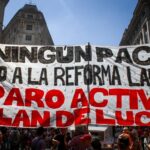
Last Wednesday, the entrance to the Ministry of Economy was full of journalists and cameras waiting for bankers to leave (Alejandro Butti (Santander), Jorge Brito (Macro), Pablo León (Galicia), Carlos Heller (Credicop), Carmen Morillo (BBVA ), among others), owners and representatives of investment funds and insurers. Economy Minister Sergio Massa met with these sectors before the opening of the “markets” to explain the new economic measureswhat forces national state agencies, such as the Anses Sustainability Guarantee Fund (FGS), to carry out a mandatory exchange of their bonds in dollars to give liquidity to financial exchange rates.
The measure is a new slap from the minister before the few reserves (dollars that left in debt payments, imports and capital flight) to intervene in the exchange market y reduce the exchange rate gap between the wholesale dollar and financial dollarsbut for it the coffers of the FGS deteriorate. A fund whose function is to guarantee the payment of retirement and pensions in case of contingencies and not to intervene in the exchange market. The IMF stated that it was aware of the measure, but that it is evaluating it, although the “suggestion” of the sale of FGS assets was included in the official memorandum with the Fund in 2018 during the macrismo.
On the other hand, as various specialists warn, If public organizations are detaching themselves from their securities to sell them to banks, investment funds and insurance companies, external debt is being privatized at a low price. A round business for these sectors.
Another false promise: “Between the banks and the retirees, I stay with the retirees”
During the electoral campaign, the Frente de Todos repeated that retirees would be its priority and that the 20 points of purchasing power that pensions and salaries lost in the four years of macrismo would be recomposed. “Between the banks and the retirees, I’ll stay with the retirees,” said Alberto Fernández, but that did not happen. The elderly receive assets that are not enough to cover the consumption basket, that is, they do not make ends meet while the banks have million-dollar profits.
One of the first measures of the Frente de Todos government was the suspension of pension mobility and the decision to grant discretionary increases by decree through the Law of “Solidarity and Productive Reactivation”. This measure allowed a cut of $100,000 million for retirees. Then the Government promoted a new pension mobility law tied to the evolution of wages and tax collection of the Anses. With the new norm they ensured that retirements can be left behind the rise in prices and thus liquefy what is destined for the elderly. The Frente de Todos even voted against the proposal of the left to add a minimum floor clause that acts as a guarantee against inflation.
The situation of retirees is critical. The economist Lucía Ortega pointed out in the debate in Deputies for the moratorium law that 91% of retirements and pensions are below the value of the Basket for the Third Age. In addition, “in the last five years the real value of retirement and pensions deteriorated between 24% and 30%. More specifically, after the suspension of pension mobility in 2020 and the new retirement formula of 2021, the minimum salaries will be collapsed 11% in the last three years, reaching a loss of 18% for maximum salaries, that is to say, that with the new pension mobility they continued to lose and that is the product of having refused to incorporate a floor that guarantees that never the retirement adjustment may be less than inflation. In 2022, the Government had the luxury of exceeding the fiscal deficit goal with the IMF and cut spending on retirement and pensions from 8% to 7.7% of GDP.
Regarding Massa’s new decision, endorsed by all the members of the Frente de Todos, Eugene SeminoOmbudsman for the Third Age of the Argentine Republic, stated in an interview with South American radio that they had demanded at the end of the year “that resources be applied from the Guarantee and Sustainability Fund that was generated back in 2007, since the law establishes that these funds should be used when the purchasing power of those who are within the system loses”.
“We had requested a readjustment of $50,000, for all retirees, pensioners and disability pensions, and this was never answered. And now we have this in response, which is to give those dollarized bonds to the friends of power. They take those bonds in dollars that play in the market and leave pesos, thus liquidating the Guarantee Fund, we are talking about 5 billion dollars,” Semino denounced. The Minister of Economy gave preferential treatment to bankers, insurers and investment funds to detail the measure while he did not respond to the retirees’ claim.
The usual suspects
Unlike the retirees, the banks continue to party. Private banks in Argentina accumulated profits of $334,467 million in 2022, or what is equal to $916 million per day. The previous years also won. The data comes from the Report on Banks of the Central Bank.
The key to the success of private banks is explained by financial speculation. The financial margin shows that the results obtained by the financial intermediation activity (interest collected on loans minus interest paid on deposits) registered a negative balance in 2022, while What private banks received from interest on securities (mainly Leliqs) and premiums for interbank repos was $4.3 trillion (around US$32.4 billion). in the same period.
The interest that the Central Bank pays to the banks for the Liquidity Letters (Leliq) means an enormous quasi-fiscal deficit, as happened with Macri and now with the Frente de Todos government, which promised in the electoral campaign that they would leave to pay.
Massa’s decision grants a new benefit to the banks since they will be able to buy AL30 bonds that mature in 2030 for US$ 100, but are trading at US$ 25 and it was authorized that those who buy (investment funds, banks and insurers) can send your profits through cash with liqui with those bonuses.
Horacio Rovelli published in El Cohete a la Luna that although this operation will stop the increase in parallel exchange rates, it will be at the expense of the State, which must pay out the nominal value (US$100 each bond) at maturity. Besides, The economist denounced the constant subsidy of the bosses’ governments to the banks. “The BCRA pays, this year 2023, an income to the ten largest private banks of no less than 5 trillion pesos (about 20,000 million dollars)”added Rovelli. Who are the “planeros” that will receive part of these millions? The following banks: Galicia, Santander, Macro, BBVA, Credicoop, ICBC, HSBC, Patagonia, Supervielle, and Citi Bank.
Banks occupy an important place in the economy, but they are managed by a few private profit-driven. It is necessary the nationalization of the banksand form a single state bank. This measure would protect deposits for small and medium savers and prevent them from being taken away by banks as happened in the 2001 crisis. National savings could also be channeled towards credit to develop the most urgent activities, not for financial speculation. , and respond to social needs, such as investment in infrastructure, but also for the activities of merchants, workshop owners, etc.
The nationalization of the financial system is part of a joint program to face the national crisis and fight for a way out of the working class.
Source: www.laizquierdadiario.com

